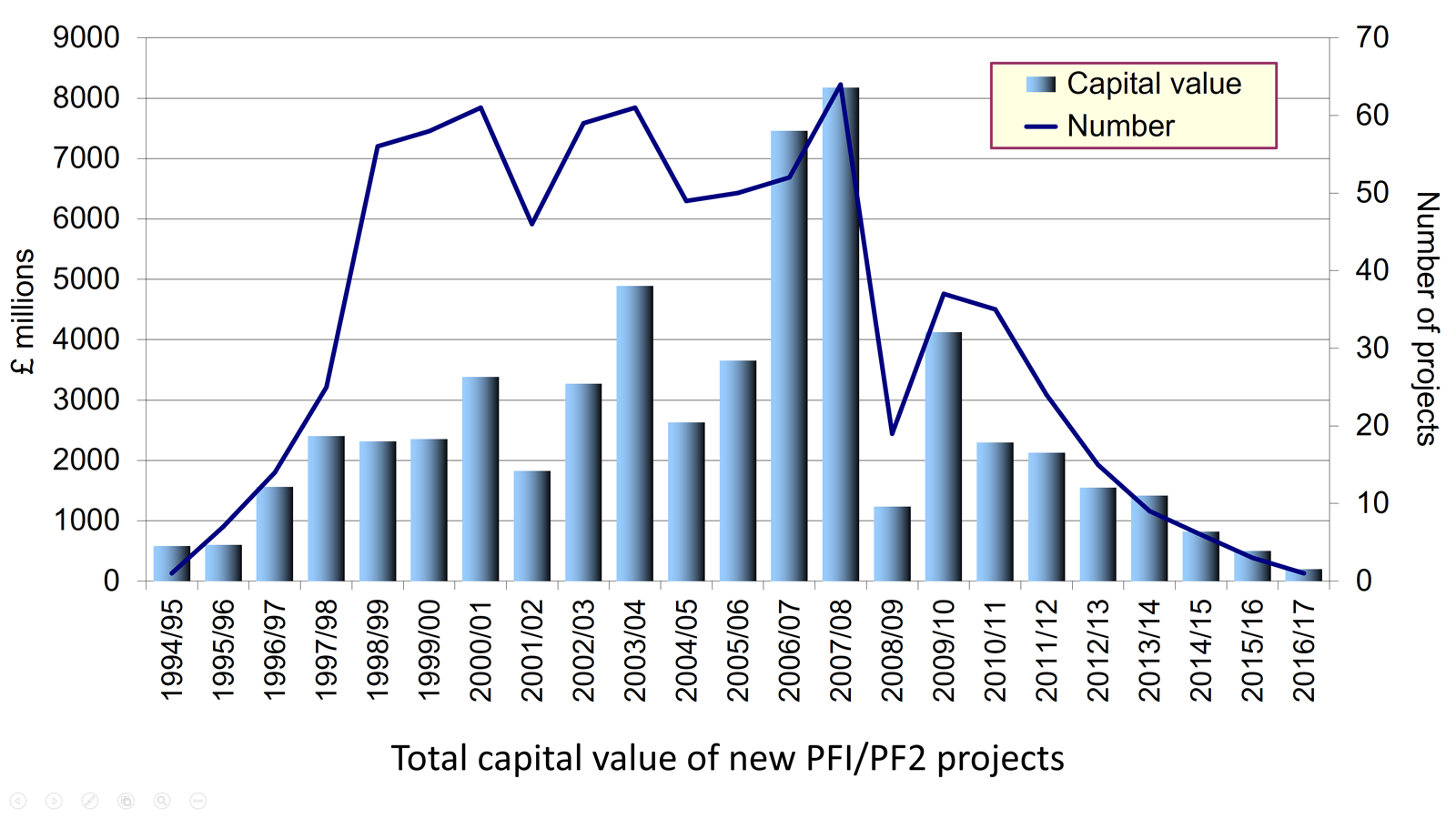Outsourcing, PFI and the demise of Carillion
 On 15 January 2018, Carillion went into liquidation. It was a major construction, civil engineering and facilities management company in the UK and was involved in a large number of public- and private-sector projects. Many of these were as a partner in a joint venture with other companies.
On 15 January 2018, Carillion went into liquidation. It was a major construction, civil engineering and facilities management company in the UK and was involved in a large number of public- and private-sector projects. Many of these were as a partner in a joint venture with other companies.
It was the second largest supplier of construction and maintenance services to Network Rail, including HS2. It was also involved in the building of hospitals, including the new Royal Liverpool University Hospital and Midland Metropolitan Hospital in Smethwick. It also provided maintenance, cleaning and catering services for many schools, universities, hospitals, prisons, government departments and local authorities. In addition it was involved in many private-sector projects.
Much of the work on the projects awarded to Carillion was then outsourced to other companies, many of which are small construction, maintenance, equipment and service companies. A large number of these may themselves be forced to close as projects cease and many bills remain unpaid.
Many of the public-sector projects in which Carillion was involved were awarded under the Public Finance Initiative (PFI). Under the scheme, the government or local authority decides the service it requires, and then seeks tenders from the private sector for designing, building, financing and running projects to provide these services. The capital costs are borne by the private sector, but then, if the provision of the service is not self-financing, the public sector pays the private firm for providing it. Thus, instead of the public sector being an owner of assets and provider or services, it is merely an enabler, buying services from the private sector. The system is known as a Public Private Partnership.
Clearly, there are immediate benefits to the public finances from using private, rather than public, funds to finance a project. Later, however, there is potentially an extra burden of having to buy the services from the private provider at a price that includes an element for profit. What is hoped is that the costs to the taxpayer of these profits will be more than offset by gains in efficiency.
Critics, however, claim that PFI projects have resulted in poorer quality of provision and that cost control has often been inadequate, resulting in a higher burden for the taxpayer in the long term. What is more, many of the projects have turned out to be highly profitable, suggesting that the terms of the original contracts were too lax.
There was some modification to the PFI process in 2012 with the launching of the government’s modified PFI scheme, dubbed PF2. Most of the changes were relatively minor, but the government would act as a minority public equity co-investor in PF2 projects, with the public sector taking stakes of up to 49 per cent in individual private finance projects and appointing a director to the boards of each project. This, it was hoped, would give the government greater oversight of projects.
With the demise of Carillion, there has been considerable debate over outsourcing by the government to the private sector and of PFI in particular. Is PFI the best model for funding public-sector investment and the running of services in the public sector?
On 18 January 2018, the National Audit Office published an assessment of PFI and PF2. The report stated that there are currently 716 PFI and PF2 projects either under construction or in operation, with a total capital value of £59.4 billion. In recent years, however, ‘the government’s use of the PFI and PF2 models has slowed significantly, reducing from, on average, 55 deals each year in the five years to 2007-08 to only one in 2016-17.’
Should the government have closer oversight of private providers? The government has been criticised for not heeding profit warnings by Carillion and continuing to award it contracts.
Should the whole system of outsourcing and PFI be rethought? Should more construction and services be brought ‘in-house’ and directly provided by the public-sector organisation, or at least managed directly by it with a direct relationship with private-sector providers? The articles below consider these issues.
Articles
Carillion collapse: How can one of the Government’s biggest contractors go bust? Independent, Ben Chu (15/1/18)
The main unanswered questions raised by Carillion’s collapse The Telegraph, Jon Yeomans (15/1/18)
Carillion taskforce to help small firms hit by outsourcer’s collapse The Telegraph, Rhiannon Curry (18/1/18)
Carillion Q&A: The consequences of collapse and what the government should do next The Conversation, John Colley (17/1/18)
UK finance watchdog exposes lost PFI billions Financial Times, Henry Mance and George Parker (17/1/18)
PFI not ‘fit for purpose’, says UK provider Financial Times, Gill Plimmer and Jonathan Ford (6/11/17)
Revealed: The £200bn Cost Of ‘Wasteful’ PFI Contracts Huffington Post, George Bowden (18/1/18)
U.K. Spends $14 Billion Per Year on Carillion-Style Projects Bloomberg, Alex Morales (18/1/18)
Carillion may have gone bust, but outsourcing is a powerful public good The Guardian, John McTernan (17/1/18)
PFI deals ‘costing taxpayers billions’ BBC News (18/1/18)
Taxpayers will need to pay £200bn PFI bill, says Watchdog ITV News (18/1/18)
The PFI bosses fleeced us all. Now watch them walk away The Guardian, George Monbiot (16/1/18)
Carillion’s collapse shows that we need an urgent review of outsourcing The Guardian, David Walker (16/1/18)
Carillion collapse: What next for public services? LocalGov, Jos Creese (16/1/18)
Taxpayers to foot £200bn bill for PFI contracts – audit office The Guardian, Rajeev Syal (18/1/18)
Official publications
A new approach to public private partnerships HM Treasury (December 2012)
Private Finance Initiative and Private Finance 2 projects: 2016 summary data GOV.UK
PFI and PF2 National Audit Office (18/1/18)
Questions
- Why did Carillion go into liquidation? Could this have been foreseen?
- Identify the projects in which Carillion has been involved.
- What has the government proposed to deal with the problems created by Carillion’s liquidation?
- What are the advantages and disadvantages of the Private Finance Initiative?
- Why have the number and value of new PFI projects declined significantly in recent years?
- How might PFI projects be tightened up so as to retain the benefits and minimise the disadvantages of the system?
- Why have PFI cost reductions proved difficult to achieve? (See paragraphs 2.7 to 2.17 in the National Audit Office report.)
- How would you assess whether PFI deals represent value for money?
- What are the arguments for and against public-sector organisations providing services, such as cleaning and catering, directly themselves rather than outsourcing them to private-sector companies?
- Does outsourcing reduce risks for the public-sector organisation involved?

